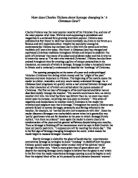In ‘A Christmas Carol’, Charles Dickens represents Scrooge as an unsympathetic man who is offered the opportunity to redeem himself. Through the use of language, the reader is positioned to view him adversely, but during the journey of the morality lessons shown by three spirits, Scrooge recovers his sense of joy and feeling by undergoing a life-changing transformation. In the form of an allegory, Dickens demonstrates a defiant and isolated character who transforms into a changed man imbued with Christmas spirit through the confrontations of Marley’s Ghost, and the Spirits of Christmas Past, Present, and Yet to Come.
In ‘A Christmas Carol’, Scrooge is confronted by his deceased partner’s ghost, Jacob Marley, and the first of the Spirits of Christmas. Marley’s Ghost has come to warn Scrooge to change his avarice ways or he, too, will be condemned to wander the Earth in the pain he has caused and the happiness he cannot share, weighed down by ‘the chain [he] forged in life’ which he has made ‘link by link, and yard by yard’. Dickens uses the metaphor to contribute to the burden Marley carries because of the selfish ways he has acted in his life on Earth. Scrooge is shaken by what has happened to his sole friend, who offers no console and furthermore exemplifies his fate by showing him the phantoms who, like Marley, wore chains and were linked together, unable to be free as ‘misery with them all was, clearly, that they sought to interfere, for good…and had lost the power for ever’ as for the dead, it is too late for anything. The Spirit of Christmas Past, visits to reminisce Scrooge’s unhappy childhood as a ‘solitary child, neglected by his friends’. Scrooge pities himself, and wishes that he had given something to the boy ‘singing a Christmas Carol at [his] door last night’, which becomes his first step to his transformation.







